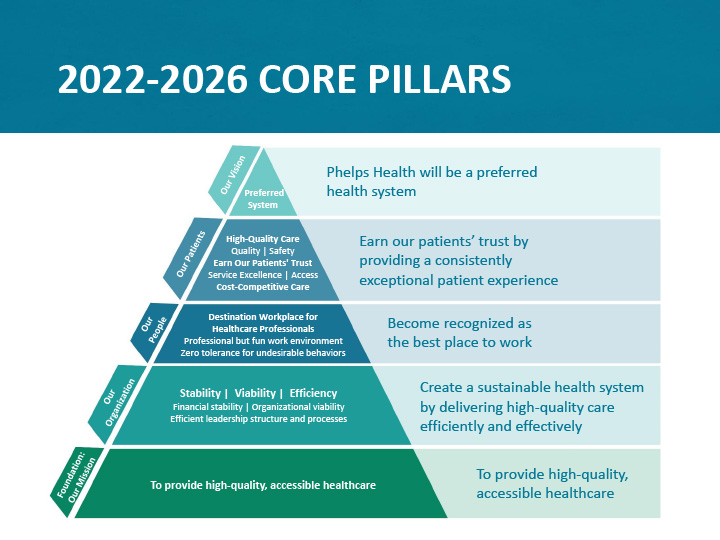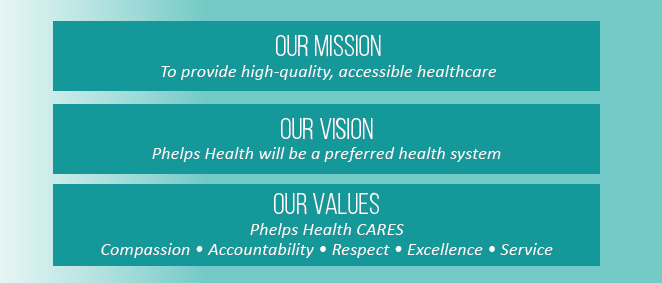
Published on March 17, 2022
Read Time: Three Minutes
One thing is certain in healthcare: the landscape is constantly changing.
While healthcare organizations cannot predict the future or control outside factors, such as economic trends, technology changes and government regulations, they can establish a plan that helps to keep them on the path to excellence and allow ways to measure their success.
Enter the strategic plan -- a document that serves as an organization’s guide. The purpose of a strategic plan is to identify the overall goals for an organization and to develop a realistic plan to achieve them.
The process for strategic planning involves looking at the big picture, such as what an organization’s purpose is, where the organization is going and what its priorities should be.
After several months of meeting and planning, the Phelps Health Board of Trustees approved the new 2022-2026 organizational strategic plan in December 2021.
While Phelps Health’s new strategic plan includes updated mission, vision and values statements, the organization’s overall objectives are based upon three pillars, which includes our patients, our people and our organization.

“In the strategic plan, our mission, or why we exist, is the foundation that we built everything else upon. The three core pillars (our patients, our people and our organization) served as the guiding principles to establish our organization’s goals,” said Jason Shenefield, president and CEO of Phelps Health.
“After examining our mission and core pillars, we identified ways to effectively measure and achieve these goals, such as delivering high-quality care efficiently and effectively, becoming a best place to work and earning our patients’ trust by consistently providing an exceptional patient experience,” he said.
While Shenefield acknowledged the organization has implemented strategic plans in the past and people may not have recognized any substantial changes from those efforts, he said one of the differences to the strategic plan this time is the approach Phelps Health is taking.
“We are asking our employees for suggestions on how we can be better,” he said. “They are the ones who see and experience many of the obstacles we face as an organization, and they have insight into how we may best be able to address and fix these challenges.”
If the mission statement serves as the basis for why an organization exists, then the vision statement is where an organization wants to go in the future.
“A vision statement’s purpose is to say, ‘based on our mission, this is where we want to be someday,’” said Shenefield.
For Phelps Health, consistently referring back to the organization’s strategic plan is critical to success.
“We put a lot of time and effort into creating our mission, vision, goals and focus areas,” Shenefield said. “We wanted to ensure our efforts and initiatives benefited and aligned with our overall organizational goals.
“Through consistently talking about our strategic plan, we can start to build a culture that not only works to support these efforts but also begins to make decisions based on these concepts. The eventual goal is to have everyone humming along and working together to achieve the same objectives,” he said.
Getting everyone focused on the same goals does not happen overnight, but according to Shenefield, this is another reason why a strategic plan is so crucial.
“When you can reference a plan and tell any employee, patient or community member the same message: that we are working toward x, y or z, then that repetitiveness begins to sink in,” Shenefield said.
“Eventually, people begin to understand what the organization has set out to do, how these efforts are being measured and how key stakeholders like themselves (e.g., patients, employees, community members, etc.) play an important part in the organization’s success,” he said.